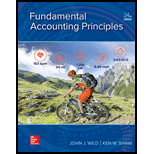
Concept explainers
Concept Introduction:
Predetermined
Predetermined overhead allocation rate is calculated as follows-
To determine Predetermined overhead rate
Answer to Problem 16E
Predetermined overhead rate
Explanation of Solution
Predetermined overhead rate Given,
- Estimated overhead cost = $1,680,000
- Estimated direct labor cost = $480,000
Conclusion:
Thus, the predetermined overhead determined is 350%.
Concept Introduction:
T-Account
T-Account is most common type of account. It is the simplest account which makes study of accounting very simple.
This accounts resembles with the English letter 'T'.
T-account has three parts-
- The title
- The debit which is on the left side
- The credit which is on the right side T-Accounts are useful tools for accountants as it helps them to analyze company accounts in effective way.
To set up T-account and determine the applied overhead cost.
Answer to Problem 16E
Applied overhead cost is calculated as follows-
T-Account for factory overhead
| Factory Overhead | |||
| Particulars | Amount ($) | Particulars | Amount ($) |
| Actual overhead | 1,652,000 | Applied overhead | 1,662,500 |
| Factory overhead (overapplied) | 10,500 | ||
| Total | 1,662,500 | Total | 1,662,500 |
Explanation of Solution
Applied Overhead cost-
Given,
- Direct labor cost = $475,000
- Predetermined overhead rate = 350% (calculated in part1)
T-account
Given,
- Actual overhead = $1,652,000
- Applied Overhead = $1,662,500 (Calculated above)
Conclusion:
Thus, applied overhead cost is calculated and T-account is prepared.
Concept Introduction:
Under or Over applied overhead-
Under or Over applied overhead- It is the difference between the actual and applied overhead.
If the actual overhead incurred is more than the overhead applied during a particular period, then it is a case of under-applied of overhead cost.
If the actual overhead incurred is less than the overhead applied during a particular period, then it is a case of over-applied of overhead cost.
To determine the overapplied or underapplied overhead.
Answer to Problem 16E
Overapplied overhead is calculated as follows-
Explanation of Solution
Given,
- Actual overhead = $1,652,000
- Applied Overhead = $1662,500 (Calculated above)
Since, actual overhead incurred is less than the overhead applied, so overhead is overapplied.
Conclusion:
Thus, overapplied overhead cost calculated is $10,500.
Concept Introduction:
Adjusting entries are prepared to complete the financial statement of the company and to reflect the accrual method of accounting. Adjusting entries are prepared before issuance of financial statement.
To prepare:
To prepare adjusting entry to allocate underapplied overhead costs.
Answer to Problem 16E
| S.No. | Accounts titles and Explanation | Debit ($) | Credit ($) |
| Factory overhead | 10,500 | ||
| Cost of goods sold | 10,500 | ||
| (To assign overapplied overhead costs to Cost of goods sold) |
Explanation of Solution
Overhead is overapplied which means applied overhead is more than the actual overhead. Cost of goods sold is a cost and its balance is decreasing so it is credited and Factory overhead is debited.
Conclusion:
Thus, adjusting entry is prepared.
Want to see more full solutions like this?
Chapter 19 Solutions
FUND.ACCT.PRIN.(LOOSELEAF)-W/ACCESS
- I am searching for the accurate solution to this general accounting problem with the right approach.arrow_forwardPlease provide the correct answer to this general accounting problem using valid calculations.arrow_forwardCan you solve this general accounting question with the appropriate accounting analysis techniques?arrow_forward
- Please explain the solution to this general accounting problem using the correct accounting principles.arrow_forwardCan you solve this general accounting problem using appropriate accounting principles?arrow_forwardI need help solving this general accounting question with the proper methodology.arrow_forward

 AccountingAccountingISBN:9781337272094Author:WARREN, Carl S., Reeve, James M., Duchac, Jonathan E.Publisher:Cengage Learning,
AccountingAccountingISBN:9781337272094Author:WARREN, Carl S., Reeve, James M., Duchac, Jonathan E.Publisher:Cengage Learning, Accounting Information SystemsAccountingISBN:9781337619202Author:Hall, James A.Publisher:Cengage Learning,
Accounting Information SystemsAccountingISBN:9781337619202Author:Hall, James A.Publisher:Cengage Learning, Horngren's Cost Accounting: A Managerial Emphasis...AccountingISBN:9780134475585Author:Srikant M. Datar, Madhav V. RajanPublisher:PEARSON
Horngren's Cost Accounting: A Managerial Emphasis...AccountingISBN:9780134475585Author:Srikant M. Datar, Madhav V. RajanPublisher:PEARSON Intermediate AccountingAccountingISBN:9781259722660Author:J. David Spiceland, Mark W. Nelson, Wayne M ThomasPublisher:McGraw-Hill Education
Intermediate AccountingAccountingISBN:9781259722660Author:J. David Spiceland, Mark W. Nelson, Wayne M ThomasPublisher:McGraw-Hill Education Financial and Managerial AccountingAccountingISBN:9781259726705Author:John J Wild, Ken W. Shaw, Barbara Chiappetta Fundamental Accounting PrinciplesPublisher:McGraw-Hill Education
Financial and Managerial AccountingAccountingISBN:9781259726705Author:John J Wild, Ken W. Shaw, Barbara Chiappetta Fundamental Accounting PrinciplesPublisher:McGraw-Hill Education





